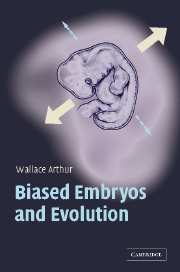Book contents
- Frontmatter
- Contents
- Preface
- Acknowledgements
- 1 The microscopic horse
- 2 What steers evolution?
- 3 Darwin: pluralism with a single core
- 4 How to build a body
- 5 A brief history of the last billion years
- 6 Preamble to the quiet revolution
- 7 The return of the organism
- 8 Possible creatures
- 9 The beginnings of bias
- 10 A deceptively simple question
- 11 Development's twin arrows
- 12 Action and reaction
- 13 Evolvability: organisms in bits
- 14 Back to the trees
- 15 Stripes and spots
- 16 Towards ‘the inclusive synthesis’
- 17 Social creatures
- Glossary
- References
- Index
14 - Back to the trees
Published online by Cambridge University Press: 02 December 2009
- Frontmatter
- Contents
- Preface
- Acknowledgements
- 1 The microscopic horse
- 2 What steers evolution?
- 3 Darwin: pluralism with a single core
- 4 How to build a body
- 5 A brief history of the last billion years
- 6 Preamble to the quiet revolution
- 7 The return of the organism
- 8 Possible creatures
- 9 The beginnings of bias
- 10 A deceptively simple question
- 11 Development's twin arrows
- 12 Action and reaction
- 13 Evolvability: organisms in bits
- 14 Back to the trees
- 15 Stripes and spots
- 16 Towards ‘the inclusive synthesis’
- 17 Social creatures
- Glossary
- References
- Index
Summary
Why so little phylogeny – evolutionary trees, that is – until now? Why, if the pattern of relationships among organisms provides a firm foundation against which to investigate the evolution of development, have I left it so late? When I wrote my last book – The Origin of Animal Body Plans – I put the ‘trees’ chapter near the front; yet now it is near the back. This is not simple inconsistency. Rather, it's intentional, and now it's time to explain the reason behind this design.
Although I started off by contrasting three types of trees – adult, embryo and life-cycle trees – only one picture of evolutionary trees has appeared between then and now (in Chapter 5). How have we been able to proceed so far with so few trees? It all comes back to the difference between natural history and natural philosophy, and to the nature of the whole evo-devo endeavour.
The disciplines of population genetics and palaeontology contrast markedly in relation to their ‘ahistorical’ and historical natures. Population genetics investigates general mechanisms that should be applicable across the whole of evolutionary time, while palaeontology focuses on particular historical sequences that, if you move backwards or forwards in time, are replaced by entirely different ones. This is a bit of an oversimplification, because palaeontology has spawned general theories of its own, such as species selection, and population genetics includes some case studies that have a definite historical dimension. Nevertheless, the general contrast is a reasonable one.
How can evo-devo be classified in this respect? Is it natural philosophy or natural history? Does it seek general theories or historical reconstructions? In my view, it seeks both.
- Type
- Chapter
- Information
- Biased Embryos and Evolution , pp. 158 - 173Publisher: Cambridge University PressPrint publication year: 2004



